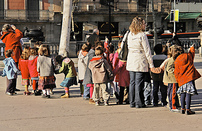Daycare is education. Why isn’t it better?

Photo by njxw on Flickr.
The cover story of the New Republic this week describes the “hell of American day care.” While it goes into detail on a few extreme cases, the article also asks a very important question. Given what we know about early childhood cognitive development, why do we treat the environment infants and toddlers find themselves in with such disregard?
The article intersperses analysis of the state of American daycare amidst the saga of Jessica Tata, a daycare operator who takes on too many children, has no training, and in absence of oversight starts taking more and more shortcuts, culminating in shopping at Target while children are left unsupervised in a facility that catches fire.
While this and the other similar cases that author Jonathan Cohn relates to the reader do not represent the typical experience of parents and children with daycare services, undeniably the staff who care for the children of most American families from just after birth until age 5 are poorly trained, poorly paid, and poorly regulated.
Unsurprisingly, the care they provide is often of unacceptable quality. Cohn cites the National Institute of Child Health Development as scoring a majority of daycare providers as “fair” or “poor,” and only 10% as “high quality.”
This happens in part because the economic burden for some of the most critical years in a child’s development falls squarely on the parent, leavened only by an unrefundable tax credit that of little use to low-income families, and covers less than a third of the average cost of infant care in DC.
The “best practice” for early education is well known to be France’s model of heavily-
subsidized care from birth until age 3, and free public preschool afterwards. These crèches have staff with degrees in child care and psychology, to make the most of the learning opportunity that is this period in a child’s life. Meanwhile, daycare in the US is treated like a burden, the price families pay for violating 1950s norms by having two parents at work.
This, of course, presupposes parents can even access daycare at all. The prices in the Washington area, and in many other large metropolitan areas, are so high because the “market” rather stubbornly will not “solve” the problem. If there were ever a one-phrase rejoinder to the Efficient Market Hypothesis, it is the waiting list at almost every daycare center in the city.
Parents cannot shop around, or leave one center if its standards are shoddy, for there is essentially no chance they would be able to find another space for their child on short notice. This has been a problem for years, and the market has not resolved the problem.
How bad off are we in DC? Well, according to Child Care Aware (formerly the NCCRRAA) we’re doing reasonably well by US standards at regulating day care facilities, though not as well with “home daycare” operations. However, we pay an average of $20,178 per child per year, the highest average in the United States.
As for availability, while good data is hard to find on the length of waiting lists (partly because most daycare centers are reluctant to share that information), people on local forum DC Urban Moms & Dads discussed how frequently to call a given center at what point during one’s pregnancy in hopes of securing a space down the road.
Why don’t we have government-provided child care, like most of Europe? This is why. The hostility on the right to collective solutions has reached a crescendo. Apparently, if you even suggest that the community/society/government has an interest in the raising of your children, especially at a young age, some will say you are “demonstrating some of the most evil views about family and society, and there is no quicker route to destroy and dehumanize individuals than through a collectivized education system” (read: public day care, preschool, and presumptively public education altogether).
These are the most critical years of a child’s development. Society has an interest in ensuring the child is well cared for and given every opportunity to make the most of this time. Until we realize that—and reflect it in policy—we’ll find a lot of issues with these children that manifest later on in their lives seem intractable and unsolvable.
